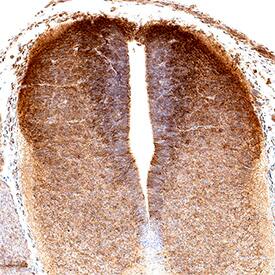Mouse IGFBP-L1 Antibody
R&D Systems, part of Bio-Techne | Catalog # AF4130


Key Product Details
Species Reactivity
Validated:
Cited:
Applications
Validated:
Cited:
Label
Antibody Source
Product Specifications
Immunogen
Leu18-Leu270
Accession # Q80W15
Specificity
Clonality
Host
Isotype
Scientific Data Images for Mouse IGFBP-L1 Antibody
Detection of IGFBP-L1 in Mouse Embryo Brain.
IGFBP-L1 was detected in immersion fixed paraffin-embedded sections of mouse embryo brain using Goat Anti-Mouse IGFBP-L1 Antigen Affinity-purified Polyclonal Antibody (Catalog # AF4130) at 5 µg/ml for 1 hour at room temperature followed by incubation with the Anti-Goat IgG VisUCyte™ HRP Polymer Antibody (Catalog # VC004). Before incubation with the primary antibody, tissue was subjected to heat-induced epitope retrieval using VisUCyte Antigen Retrieval Reagent-Basic (Catalog # VCTS021). Tissue was stained using DAB (brown) and counterstained with hematoxylin (blue). Specific staining was localized to the cytoplasm. View our protocol for Chromogenic IHC Staining of Paraffin-embedded Tissue Sections.Applications for Mouse IGFBP-L1 Antibody
Immunohistochemistry
Sample: Immersion fixed paraffin-embedded sections of mouse embryo brain
Western Blot
Sample: Recombinant Mouse IGFBP-L1 (Catalog # 4130-BL)
Formulation, Preparation, and Storage
Purification
Reconstitution
Formulation
Shipping
Stability & Storage
- 12 months from date of receipt, -20 to -70 °C as supplied.
- 1 month, 2 to 8 °C under sterile conditions after reconstitution.
- 6 months, -20 to -70 °C under sterile conditions after reconstitution.
Background: IGFBP-L1
Insulin-like Growth Factor Binding Protein-Like 1 (IGFBP‑L1), also known as IGFBP-rP4, is a 38 kDa secreted member of the IGFBP superfamily of proteins. IGFBP superfamily members are cysteine-rich proteins with conserved cysteine residues, which are clustered in the amino- and carboxy-terminal thirds of the molecule. IGFBPs modulate the biological activities of IGF proteins (1). IGFBP-L1 contains an N-terminal IGFBP motif, a Kazal-type serine protease inhibitor region, and a C-terminal Ig-like domain (2, 3). Mature mouse IGFBP-L1 shares 76% and 96% amino acid (aa) sequence identity with human and rat IGFBP-L1, respectively. It shares 38%-41% aa sequence identity with mouse IGFBP-7 and IGFBP-rp10 and 20%‑24% aa sequence identity with mouse IGFBP-1, -2, -3, -4, -5, and -6. IGFBP-L1 is most highly expressed in testis and brain, while lower levels are more broadly expressed (3). IGFBP-L1 is expressed in regionally and temporally distinct patterns during forebrain development (4). IGFBP-L1 inhibits cell proliferation in vitro and is downregulated in many colon and lung tumors (3). Transcriptional downregulation by promoter methylation is predictive of breast cancer aggressiveness (5).
References
- Firth, S.M. and R.C. Baxter (2002) Endocr. Rev. 23:824.
- Accession # Q80W15.
- Cai, Z. et al. (2005) Biochem. Biophys. Res. Commun. 331:261.
- Gonda, Y. et al. (2007) Gene Expr. Patterns 7:431.
- Smith, P. et al. (2007) Clin. Cancer Res. 13:4061.
Long Name
Alternate Names
Gene Symbol
UniProt
Additional IGFBP-L1 Products
Product Documents for Mouse IGFBP-L1 Antibody
Product Specific Notices for Mouse IGFBP-L1 Antibody
For research use only